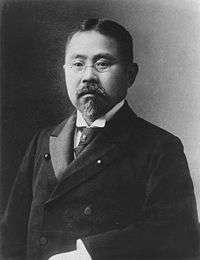Kikuchi Dairoku
| Kikuchi Dairoku | |
|---|---|
 | |
| Born |
17 March 1855 Edo, Japan |
| Died |
19 August 1917 (aged 62) Tokyo, Japan |
| Nationality | Japanese |
| Scientific career | |
| Fields | mathematics |
| Signature | |
|
| |
Baron Kikuchi Dairoku (菊池 大麓, 17 March 1855 – 19 August 1917) was a mathematician, educator, and education administrator in Meiji period Empire of Japan.
Life and career
Kikuchi was born in Edo (present-day Tokyo), as the second son of Mitsukuri Shūhei, himself the adopted son of Mitsukuri Gempo, a Shogunate professor. Kikuchi Dairoku changed his name from Mitsukuri upon succeeding as the heir to his father's original family; the requisite legal procedures were completed in 1877.[1] After attending the Bansho Shirabesho, the Shogunal institute for western studies, he was sent to Great Britain, in 1866, at age 11, the youngest of a group of Japanese sent by the Tokugawa shogunate to the University College School, on the advice of the then British foreign minister Edward Stanley, 15th Earl of Derby.
Kikuchi returned to England in 1870 and was the first Japanese student to graduate from the University of Cambridge (St. John's College) and the only one to graduate from the University of London in the 19th century.[2] His specialization was in physics and mathematics. In 1884 he attended the International Meridian Conference in Washington, D.C. and the master class of Kelvin in Baltimore.
After returning to Japan, Kikuchi later became president of Tokyo Imperial University, Minister of Education (1901–1903,) and president of Kyoto Imperial University. His textbook on elementary geometry was the most widely used textbook in Japan until the end of World War II.
Kikuchi was made a baron under the kazoku peerage system in 1902 and was the eighth president of the Gakushūin Peers' School. In 1917 he became the first president of RIKEN, but died that same year.
Mitsukuri family
Kikuchi was a member of one of Japan's most distinguished and outstanding families of scholars, the Mitsukuri family, at the centre of Japan's educational system in the Meiji Era. His grandfather had been a student of Dutch studies ("rangaku"). His father Mitsukuri Shuhei had taught at the Bansho-shirabesho (Institute for Investigating Barbarian Books). His children were famous scientists, and his grandson Minobe Ryōkichi became governor of Tokyo.
See also
General
- Japanese students in Britain
- Tokyo Imperial University
- University of Cambridge
- Anglo-Japanese relations
- Hayashi Tadasu — another member of the group sent to Britain in 1866, by the Bakufu
- Imperial Rescript on Education
Japanese at Cambridge
Other Japanese who studied at the University of Cambridge after Kikuchi:
British contemporaries at Cambridge
British contemporaries of Kikuchi at the University of Cambridge:
- Donald MacAlister
- Karl Pearson — a close friend and contemporary of Kikuchi at University College School and the University of Cambridge
- Charles Algernon Parsons
References & further reading
- ↑ Japanese Students at Cambridge University in the Meiji Era, 1868-1912, pg 66, Noboru Koyama
- ↑ "Kikuchi, Dairoku Yasuyuki (KKCY873DY)". A Cambridge Alumni Database. University of Cambridge. . Venn also lists him under the name 'Dairoku, Yasu-Yuki Kikuchi'. In one case his birth date is given as May 17, 1855; in the other as March 17, 1855.
- Cobbing, Andrew. The Japanese Discovery of Victorian Britain. RoutledgeCurzon, London, 1998. ISBN 1-873410-81-6
- Keane, Donald. Emperor Of Japan: Meiji And His World, 1852–1912. Columbia University Press (2005). ISBN 0-231-12341-8
- 'Kikuchi Dairoku, 1855–1917: Educational Administrator and Pioneer of Modern Mathematical Education in Japan,' by Noboru Koyama, Chapter 7, Britain & Japan: Biographical Portraits Volume 5, Global Oriental 2005, ISBN 1-901903-48-6
External links
| Wikimedia Commons has media related to Kikuchi Dairoku. |
| Wikisource has original works written by or about: Kikuchi Dairoku |
| Wikimedia Commons has media related to Representation of Imperial University (Japan). |
- Japanese Students at Cambridge University in the Meiji Era, 1868–1912: Pioneers for the Modernization of Japan, by Noboru Koyama, translated by Ian Ruxton , (Lulu Press, September 2004, ISBN 1-4116-1256-6). Kikuchi is the central figure in this book.
- Portrait of Kikuchi Dairoku on the National Diet Library database, Tokyo
- RIKEN — The Science Research Institute of Japan
- Works by Dairoku Kikuchi at Project Gutenberg
- Works by or about Kikuchi Dairoku at Internet Archive
| Academic offices | ||
|---|---|---|
| Preceded by Ryohei Okada |
President of Kyoto University 1908–1912 |
Succeeded by Mitsuru Kuhara |